Table of Contents
- Recently, the Prime Minister addressed sarpanches from across the country through a video conference on National Panchayati Raj Day.
- The first National Panchayati Raj Day was celebrated in 2010.
- Since then, the National Panchayati Raj Day is celebrated on April 24 every year in India.
- Prime Minister Launched two programmes:
- e-GramSwaraj: For monitoring of rural infrastructure works and e-governance.
- Swamitva programme: It involves mapping of rural housing and land holdings via technology including drones.
- The Swamitva programme would help rural India leverage property for institutional credit and other benefits.
Panchayati Raj
- After the Constitution came into force, Article 40 made a mention o f panchayats
- Article 246 empowered the state legislature to legislate with respect to any subject relating to local self-government.
- Panchayati Raj Institution (PRI) was constitutionalized through the 73rd Constitutional Amendment Act, 1992 to build democracy at the grass roots level and was entrusted with the task of rural development in the country.
- PRI is a system of rural local self-government in India.
- Local Self Government is the management of local affairs by such local bodies who have been elected by the local people.
Salient Features of the 73rd Constitutional Amendment
- The 73rd Constitutional Amendment added Part IX titled “The Panchayats” to the Constitution.
- Basic unit of democratic system-Gram Sabhas (villages) comprising all the adult members registered as voters.
- Three-tier system of panchayats at village, intermediate block/taluk/mandal and district levels except in States with population is below 20 lakhs (Article 243B).
- Seats at all levels to be filled by direct elections Article 243C (2).
Reservation of seats
- Seats reserved for Scheduled Castes (SCs) and Scheduled Tribes (STs) and the chairpersons of the Panchayats at all levels also shall be reserved for SCs and STs in proportion to their population.
- One-third of the total number of seats to be reserved for women.
- One-third offices of chairpersons at all levels reserved for women (Article 243D).
Duration
- Uniform five year term and elections to constitute new bodies to be completed before the expiry of the term.
- In the event of dissolution, elections compulsorily within six months (Article 243E).
- Independent Election Commission in each State for superintendence, direction and control of the electoral rolls (Article 243K).
- Power of Panchayats:
- Panchayats have been authorised to prepare plans for economic development and social justice in respect of subjects illustrated in Eleventh Schedule (Article 243G).
Source of Revenue (Article 243H)
- State legislature may authorise the Panchayats with:
- Budgetary allocation from State Revenue.
- Share of revenue of certain taxes.
- Collection and retention of the revenue it raises.
- Establish a Finance Commission in each State to determine the principles on the basis of which adequate financial resources would be ensured for panchayats and municipalities (Article 243I).
Exemptions
- The act does not apply to the states of Nagaland, Meghalaya and Mizoram and certain other areas because of socio-cultural and administrative considerations.
- These areas include:
- the Scheduled areas and the tribal areas (under Schedule VI of the Constitution) in the states.
- the hill areas of Manipur for which district councils exist,
- Darjeeling district of West Bengal for which Darjeeling Gorkha Hill Council exists.
- Parliament has extended the provisions of Part IX to Vth schedule areas through an Act called the Provisions of Panchayats (Extension to the Scheduled Areas) Act, 1996.
- Till 2019, ten states have Vth Schedule Areas. These are: Andhra Pradesh, Telangana, Chhattisgarh, Gujarat, Himachal Pradesh, Jharkhand, Madhya Pradesh, Maharashtra, Odisha and Rajasthan.
Latest Burning Issues | Free PDF






















 WhatsApp
WhatsApp